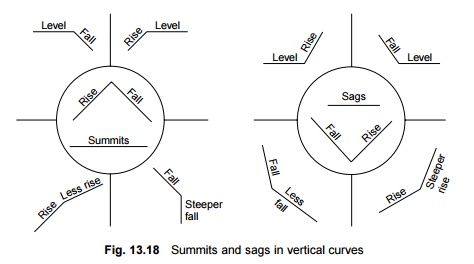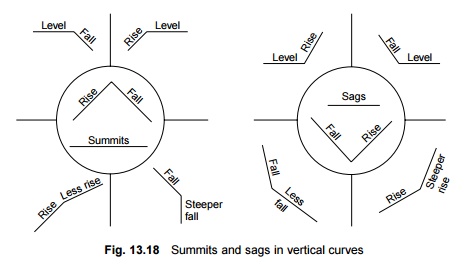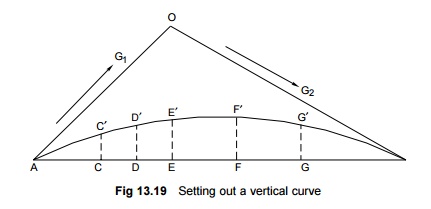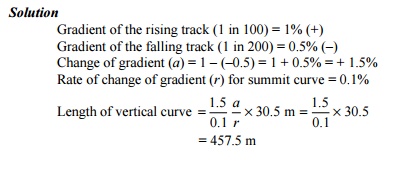Chapter: Civil : Railway Airport Harbour Engineering : Railway Engineering : Curves and Superelevation
Railway Engineering: Vertical Curves

Vertical Curves
An angle is formed at the point
where two different gradients meet, forming a summit or a sag as explained in
Fig. 13.18. The angle formed at the point of contact of the gradients is
smoothened by providing a curve called the vertical curve in the vertical
plane. In the absence of a vertical curve, vehicles are likely to have a rough
run on the track. Besides this, a change in the gradient may also cause
bunching of vehicles in the sags and a variation in the tension of couplings in
the summits, resulting in train parting and an uncomfortable ride. To avoid
these ill effects, the change in gradient is smoothened by providing a vertical
curve. A rising gradient is normally considered positive and a failing gradient
is considered negative.
A
vertical curve is normally designed as a circular curve. The circular profile
en-sures a uniform rate of change of gradient, which controls the rotational
acceleration.

1 Calculating the Length of a Vertical
Curve (Old Method)
The length of a vertical curve
depends upon the algebraic difference between the gradients and the type of
curve formed (summit or sag). The rate of change of gradient in the case of
summits should not exceed 0. 1% between successive 30.5-m (100-ft) chords,
whereas the corresponding figure for sags is 0.05% per 30.5-m (100-ft) chord.
The required length of a vertical curve for achieving the maximum permissible
speed is given by the formula
L = (a/r)
× 30.5 m (13.28) where L is the length of the vertical curve in
m, a is the per cent algebraic difference between successive gradients,
and r is the rate of change of the gradient, which is 0.1% for summit
curves and 0.05% for sag curves.
2 Existing Provisions on Indian Railways
As per the existing provisions,
vertical curves are provided only at the junction of gradients, when the
alegebraic difference between the gradients is equal to or more than 0.4 per
cent. The minimum radii for vertical curves are given in Table 13.8.
Table
13.8 Minimum radii for
vertical curves

3 Setting a Vertical Curve
A
vertical curve can be set by various methods, such as the tangent correction
method and the chord deflection method. The tangent correction method, which is
considered simpler than the other methods and is more convenient for the field
staff, is described here (Fig. 13.19). It involves the following steps.

d reduced
levels (RL) of the tangent points and apex are then worked out.
2. Tangent corrections are then computed
with the help of the following equation:
y = cx2 (13.29)
and C = g1
- g2 / 4.n
where y
is the vertical ordinate, x is the horizontal distance from the springing
point, g1 is gradient number 1 (positive for rising gradients), g2 is gradient
number 2 (negative for falling gradients), and n is the number of chords up to
half the length of the curve.
1. The
elevations of the stations on the curve are determined by algebrai adding the
tangent corrections on tangent OA.
Example
13.9 Calculate the length of the vertical curve between two
gradients meeting in a summit, one rising at a rate of 1 in 100 and the
other falling at a rate of 1 in 200.

4 New Method of Calculating Length of
Vertical Curve
According to the new method, the
length of a vertical curve is calculated as follows: L = RQ (13.30) where L is the length of the vertical curve, R
is the radius of the vertical curve as
per the existing provisions given in Table 13.8, and Q
is the difference in the percentage of gradients (expressed in radians).
It is seen that the length of the vertical curve
calculated as per the new practice is relatively small compared to the length
calculated using the old method. The length of the vertical curve according to
the new practice is considered very reasonable for the purpose of laying the
curve in the field, as can be seen from the next solved example.
Note that when the change in gradient (a)
is positive it forms a summit and when it is negative it forms a sag.
Example 13.10 A rising gradient of 1 in
100 meets a falling gradient of 1 in 200 on a group A route. The
intersection point has a chainage of 1000 m and its RL is 100 m. Calculate the
length of the vertical curve, and the RL and the chainage of the various points
in order to set a vertical curve at this location.
Solution
First gradient = 1 in 100 (rising) = + 1% Second gradient = 1
in 200 (falling) = -0.5% Difference in gradient = (+ 1) - (-0.5) = 1.5% Length
of vertical curve = L = RQ
= 4000 × (1.5/100) = 60 m Chainage of point A
(refer Fig. 13.19) = 1000 - 30 = 970 m Chainage of point B = 1000 + 30 = 1030 m
RL of point A = 100 - (30/100) = 99.70 m RL of point B = 100 -
(30/200) = 99.85 m
Increase
in RL for 60 m = 99.85 - 99.70 = 0.15 m

Related Topics